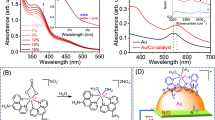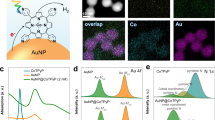Abstract
Metallic nanoparticles have been used to harvest energy from a light source and transfer it to adsorbed gas molecules, which results in a reduced chemical reaction temperature. However, most reported reactions, such as ethylene epoxidation, ammonia decomposition and H–D bond formation are exothermic, and only H–D bond formation has been achieved at room temperature. These reactions require low activation energies (<2 eV), which are readily attained using visible-frequency localized surface plasmons (from ~1.75 eV to ~3.1 eV). Here, we show that endothermic reactions that require higher activation energy (>3.1 eV) can be initiated at room temperature by using localized surface plasmons in the deep-UV range. As an example, by leveraging simultaneous excitation of multiple localized surface plasmon modes of Al nanoparticles by using high-energy electrons, we initiate the reduction of CO2 to CO by carbon at room temperature. We employ an environmental transmission electron microscope to excite and characterize Al localized surface plasmon resonances, and simultaneously measure the spatial distribution of carbon gasification near the nanoparticles in a CO2 environment. This approach opens a path towards exploring other industrially relevant chemical processes that are initiated by plasmonic fields at room temperature.
This is a preview of subscription content, access via your institution
Access options
Access Nature and 54 other Nature Portfolio journals
Get Nature+, our best-value online-access subscription
$29.99 / 30 days
cancel any time
Subscribe to this journal
Receive 12 print issues and online access
$259.00 per year
only $21.58 per issue
Buy this article
- Purchase on Springer Link
- Instant access to full article PDF
Prices may be subject to local taxes which are calculated during checkout






Similar content being viewed by others
Data availability
The data that support the findings of this study are available from the corresponding authors upon reasonable request.
References
Zhang, Y. et al. Surface-plasmon-driven hot electron photochemistry. Chem. Rev. 118, 2927–2954 (2018).
Christopher, P., Xin, H. & Linic, S. Visible-light-enhanced catalytic oxidation reactions on plasmonic silver nanostructures. Nat. Chem. 3, 467–472 (2011).
Mukherjee, S. et al. Hot electrons do the impossible: plasmon-induced dissociation of H2 on Au. Nano Lett. 13, 240–247 (2013).
Zhou, L. et al. Aluminum nanocrystal as a plasmonic photocatalyst for hydrogen dissociation. Nano Lett. 16, 1478–1484 (2016).
Hartland, G. V., Besteiro, L. V., Johns, P. & Govorov, A. O. What’s so hot about electrons in metal nanoparticles? ACS Energy Lett. 2, 1641–1653 (2017).
Christopher, P., Xin, H., Marimuthu, A. & Linic, S. Singular characteristics and unique chemical bond activation mechanisms of photocatalytic reactions on plasmonic nanostructures. Nat. Mater. 11, 1044–1050 (2012).
Yang, J., Guo, Y., Lu, W., Jiang, R. & Wang, J. Emerging applications of plasmons in driving CO2 reduction and N2 fixation. Adv. Mater. 30, 1802227 (2018).
Wang, P. et al. Ag@AgCl: a highly efficient and stable photocatalyst active under visible light. Angew. Chem. Int. Ed. 47, 7931–7933 (2008).
Christopher, P., Ingram, D. B. & Linic, S. Enhancing photochemical activity of semiconductor nanoparticles with optically active Ag nanostructures: photochemistry mediated by Ag surface plasmons. J. Phys. Chem. C 114, 9173–9177 (2010).
Ingram, D. B. & Linic, S. Water splitting on composite plasmonic-metal/semiconductor photoelectrodes: evidence for selective plasmon-induced formation of charge carriers near the semiconductor surface. J. Am. Chem. Soc. 133, 5202–5205 (2011).
Zheng, Z. et al. Facile in situ synthesis of visible-light plasmonic photocatalysts M@TiO2 (M = Au, Pt, Ag) and evaluation of their photocatalytic oxidation of benzene to phenol. J. Mater. Chem. 21, 9079–9087 (2011).
Mubeen, S. et al. An autonomous photosynthetic device in which all charge carriers derive from surface plasmons. Nat. Nanotechnol. 8, 247–251 (2013).
Zhou, L. et al. Quantifying hot carrier and thermal contributions in plasmonic photocatalysis. Science 362, 69–72 (2018).
Kale, M. J., Avanesian, T. & Christopher, P. Direct photocatalysis by plasmonic nanostructures. ACS Catal. 4, 116–128 (2014).
Zhang, X., Chen, Y. L., Liu, R.-S. & Tsai, D. P. Plasmonic photocatalysis. Rep. Prog. Phys. 76, 046401 (2013).
Yang, W.-C. D. et al. Site-selective CO disproportionation mediated by localized surface plasmon resonance excited by electron beam. Nat. Mater. 18, 614–619 (2019).
Hunt, J. et al. Microwave-specific enhancement of the carbon–carbon dioxide (Boudouard) reaction. J. Phys. Chem. C 117, 26871–26880 (2013).
Marchon, B., Tysoe, W. T., Carrazza, J., Heinemann, H. & Somorjai, G. A. Reactive and kinetic properties of carbon monoxide and carbon dioxide on a graphite surface. J. Phys. Chem. 92, 5744–5749 (1988).
Strange, J. F. & Walker, P. L.Jr. Carbon–carbon dioxide reaction: Langmuir–Hinshelwood kinetics at intermediate pressures. Carbon 14, 345–350 (1976).
Batson, P. E. A new surface plasmon resonance in clusters of small aluminum spheres. Ultramicroscopy 9, 277–282 (1982).
McClain, M. J. et al. Aluminum nanocrystals. Nano Lett. 15, 2751–2755 (2015).
Fujimoto, F. & Komaki, K.-I. Plasma oscillations excited by a fast electron in metallic particle. J. Phys. Soc. Jpn. 25, 1679–1687 (1968).
Hohenester, U. Simulating electron energy loss spectroscopy with the MNPBEM toolbox. Comput. Phys. Commun. 185, 1177–1187 (2014).
Hohenester, U., Ditlbacher, H. & Krenn, J. R. Electron-energy-loss spectra of plasmonic nanoparticles. Phys. Rev. Lett. 103, 106801 (2009).
Busch, K., König, M. & Niegemann, J. Discontinuous Galerkin methods in nanophotonics. Laser Photonics Rev. 5, 773–809 (2011).
Seemala, B. et al. Plasmon-mediated catalytic O2 dissociation on Ag nanostructures: hot electrons or near fields? ACS Energy Lett. 4, 1803–1809 (2019).
Nordlander, P., Oubre, C., Prodan, E., Li, K. & Stockman, M. I. Plasmon Hybridization in nanoparticle dimers. Nano Lett. 4, 899–903 (2004).
Egerton, R. F., Li, P. & Malac, M. Radiation damage in the TEM and SEM. Micron 35, 399–409 (2004).
Hohenester, U. & Trügler, A. MNPBEM – a Matlab toolbox for the simulation of plasmonic nanoparticles. Comput. Phys. Commun. 183, 370–381 (2012).
Sharma, R. An environmental transmission electron microscope for in situ synthesis and characterization of nanomaterials. J. Mater. Res. 20, 1695–1707 (2005).
Mecklenburg, M. et al. Nanoscale temperature mapping in operating microelectronic devices. Science 347, 629–632 (2015).
Acknowledgements
We gratefully thank D. Sil (National Institute of Standards and Technology, now at IBM) for useful discussions. C.W., W.-C.D.Y., A.B. and A.A. acknowledge support under the cooperative research agreement between the University of Maryland and the Physical Measurement Laboratory of the National Institute of Standards and Technology (award no. 70NANB14H209), through the University of Maryland.
Author information
Authors and Affiliations
Contributions
C.W., W.-C.D.Y., and R.S. conceived and designed the research. C.W. prepared the samples, conducted in situ measurements by ESTEM and processed the data. W.-C.D.Y. and A.B. carried out electromagnetic boundary element method calculations. A.A. contributed to designing the models for simulation. D.R. and A.A. contributed to the design of the experiments and the analysis of the results. R.M. and D.R. designed and helped in conducting the GCMS experiments. All authors contributed to writing the manuscript.
Corresponding authors
Ethics declarations
Competing interests
The authors declare no competing interests.
Additional information
Publisher’s note Springer Nature remains neutral with regard to jurisdictional claims in published maps and institutional affiliations.
Supplementary information
Supplementary Information
Supplementary Figs. 1–13, Table 1 and description of data analysis methods.
Supplementary Video 1
Movie showing etching of graphite near the surface of an Al nanoparticle in a CO2 environment with a pressure of ~50 Pa, illuminated with an electron flux of ~9.1 × 10−6 nA nm−2. The movie plays at 120 times normal speed. Note the formation of pillar-shaped graphite structures due to the uneven etching rate resulting from spatial distribution of electric field around the nanoparticle. The scale bar is 25 nm.
Rights and permissions
About this article
Cite this article
Wang, C., Yang, WC.D., Raciti, D. et al. Endothermic reaction at room temperature enabled by deep-ultraviolet plasmons. Nat. Mater. 20, 346–352 (2021). https://doi.org/10.1038/s41563-020-00851-x
Received:
Accepted:
Published:
Issue Date:
DOI: https://doi.org/10.1038/s41563-020-00851-x
This article is cited by
-
Exploiting hot electrons from a plasmon nanohybrid system for the photoelectroreduction of CO2
Communications Chemistry (2024)
-
Plasmon-mediated chemical reactions
Nature Reviews Methods Primers (2023)
-
Strong synergy between gold nanoparticles and cobalt porphyrin induces highly efficient photocatalytic hydrogen evolution
Nature Communications (2023)
-
Cascaded hot electron transfer within plasmonic Ag@Pt heterostructure for enhanced electrochemical reactions
Science China Materials (2023)



